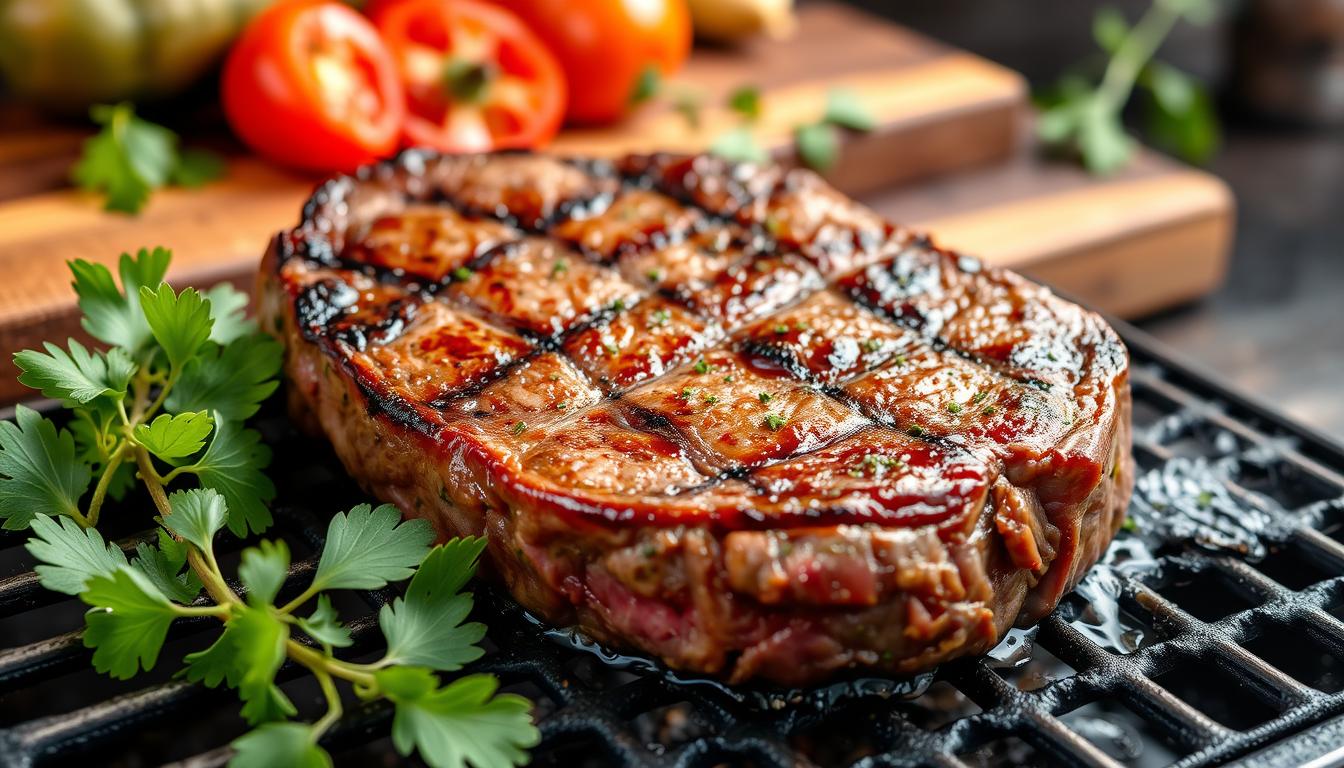When cooking with beef, you might know about ribeye or sirloin. But have you tried beef blade meat, also known as blade steak? It’s known for its rich flavor and tenderness. This makes it a top choice for many meat lovers.
Beef blade meat is great for different cooking methods. You can slow-cook it or grill it.
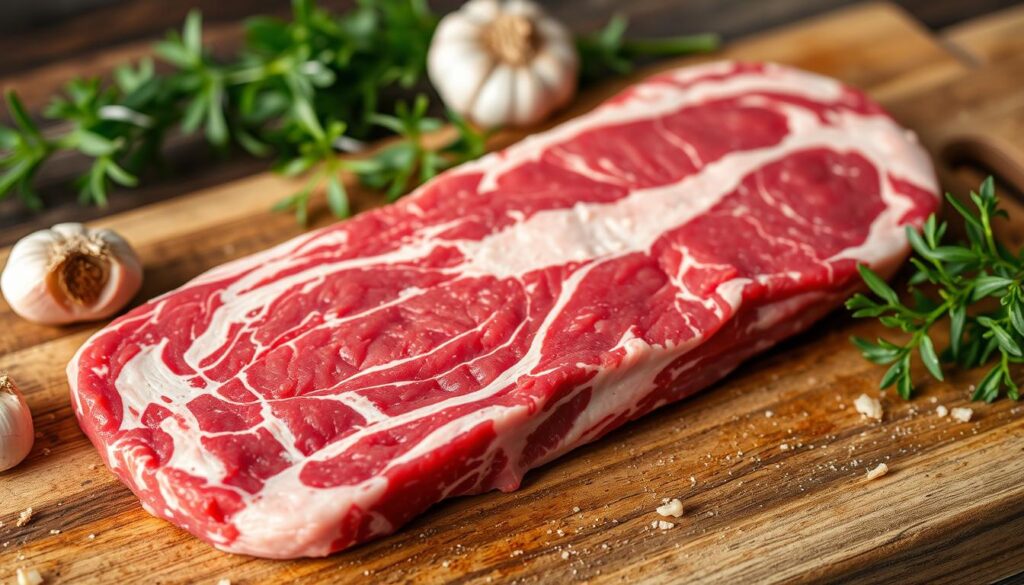
Exploring beef blade meat opens up a new world of flavors. You’ll learn about its origins and why it’s loved in kitchens everywhere. Whether you’re a pro chef or just starting, knowing about blade steak is key. It brings out the best in your dishes, with its rich taste and soft texture.
- You can achieve great flavor and tenderness with beef blade meat when cooked correctly.
- Beef blade meat, or blade steak, offers a unique combination of flavor and versatility.
- This cut is perfect for a variety of cooking methods, including slow-cooking and grilling.
- Understanding the basics of beef blade meat is key for the best flavors and textures.
- Beef blade meat is a staple in many kitchens for its rich flavor and tender texture.
- Blade steak is a favorite among many meat enthusiasts for its unique characteristics and cooking possibilities.
Understanding Beef Blade Meat
Exploring the world of beef, you’ll find many cuts with special qualities. The beef top blade steak comes from the blade section. Knowing what beef blade meat is and where it comes from is key.
The beef blade meat comes from the cow’s chuck or shoulder area. This area is famous for its rich flavor and tender texture. The beef top blade steak is loved for its marbling, which makes it tender and flavorful. Look for high-quality blade steak with good marbling for the best taste and texture.
Some key traits of beef top blade steak include:
- Rich flavor profile
- Tender texture
- Marbling, which enhances tenderness and flavor
- Versatility in cooking methods, including grilling and braising
Understanding beef blade meat helps you pick the right cut for your dishes. Whether you want a tender and flavorful blade steak or something more robust, knowing about beef blade meat is essential. It will help you improve your cooking and make better choices.
Nutritional Value of Blade Steak
Understanding the nutritional value of how to cook blade steak is key. Blade steak is packed with protein, vitamins, and minerals. It’s a top source of iron, zinc, and potassium, making it perfect for a healthy diet. Cooking methods like grilling or braising can boost its nutritional benefits.
Some of the key nutrients in blade steak include:
- Protein: essential for building and repairing muscles
- Vitamin B12: important for the production of red blood cells
- Iron: vital for healthy red blood cells
- Zinc: plays a role in immune function and wound healing
Learning how to cook blade steak healthily lets you enjoy its nutritional perks. By picking the right cooking methods and ingredients, you can make tasty, nutritious meals. Whether you’re a pro in the kitchen or just starting, knowing blade steak’s nutritional value helps you make better diet choices.
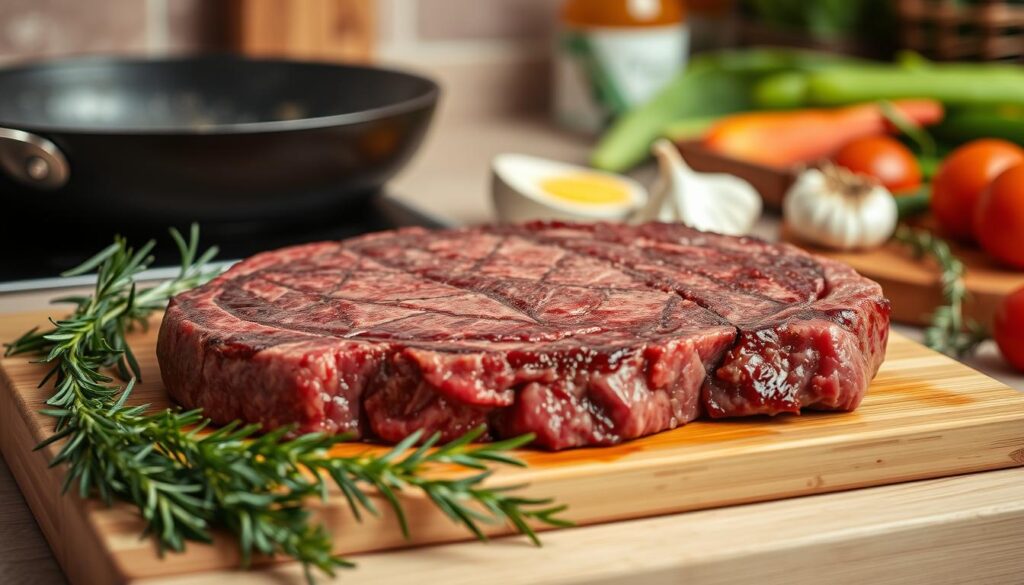
Exploring blade steak opens up a world of culinary possibilities. From stews to stir-fries, the options are vast. Adding blade steak to your meals brings variety and nutrition. It also teaches you new how to cook blade steak techniques that will wow your loved ones.
Selecting the Perfect Beef Blade Cut
Choosing the right beef blade cut is key to a tasty chuck blade steak recipe. You want a cut that will make your dish memorable. Knowing what to look for is essential.
Consider the meat’s color, marbling, and tenderness. A top-notch beef blade cut should have a rich red color. It should also have moderate marbling for extra flavor and tenderness.
Quality Indicators to Look For
- Look for cuts with a good balance of fat and lean meat
- Check the color and marbling of the meat
- Choose cuts that are fresh and have a pleasant smell
Best Places to Purchase
For the best beef blade cuts, visit your local butcher or specialty meat market. These places offer a wide range of cuts. They can also give you expert advice on picking the right one for your recipe.
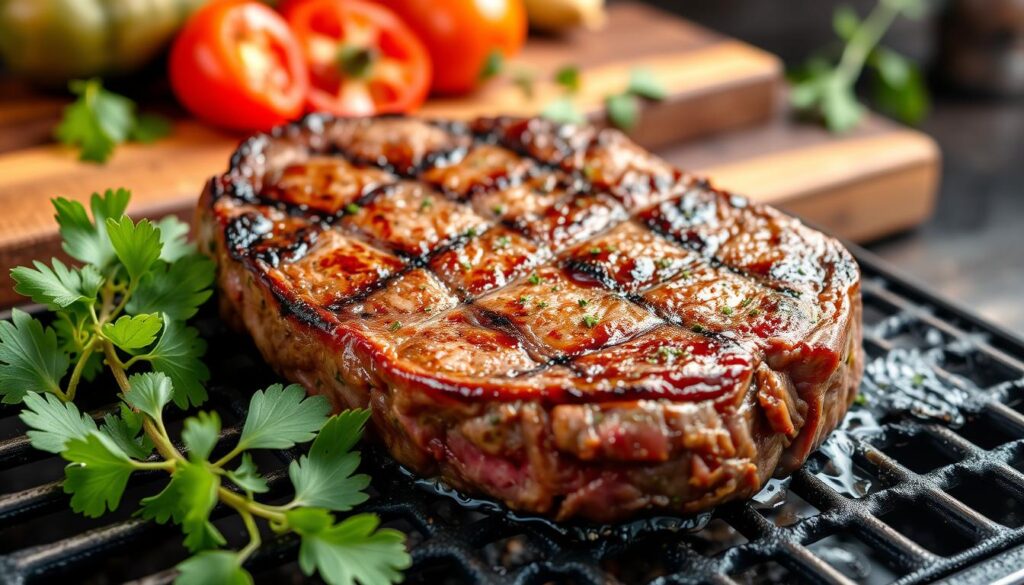
Storage Tips
To keep your beef blade cut fresh, store it in a sealed container in the fridge. Keep it at 40°F (4°C) or below. Use it within a few days or freeze it for later. These tips will help you enjoy a delicious, tender chuck blade steak every time.
| Cut of Meat | Color | Marbling |
|---|---|---|
| Beef Blade Cut | Rich Red | Moderate |
| Chuck Blade Steak | Deep Red | High |
Preparing Your Chuck Blade Steak
To get your chuck under blade steak ready for cooking, start by trimming off any extra fat. This makes the steak cook better and prevents it from getting too oily. You can use a sharp knife to cut the fat, or have your butcher do it for you.
Then, season your steak with your favorite spices and herbs. You might use salt, pepper, garlic powder, and paprika. Make sure to cover both sides of the steak evenly.
Here are some tips for preparing your chuck under blade steak:
- Pat the steak dry with a paper towel before seasoning to help the spices stick.
- Let the steak sit at room temperature for about 30 minutes before cooking to help it cook more evenly.
- Don’t press down on the steak with your spatula while it’s cooking, as this can squeeze out juices and make the steak tough.
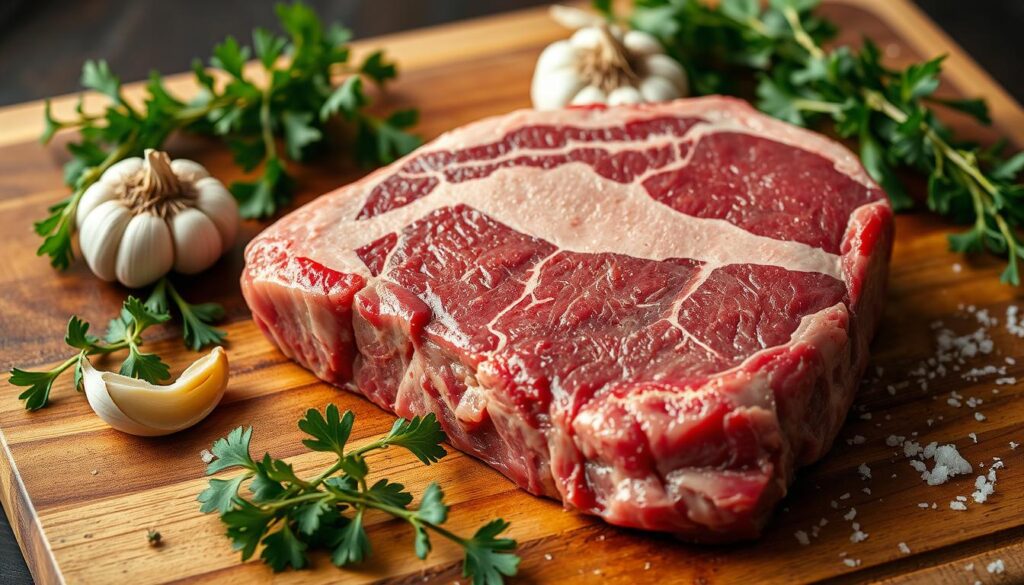
By following these tips, you can make sure your chuck blade steak is delicious and tender. Whether you’re grilling, pan-frying, or slow-cooking your steak, proper preparation is key to a great meal.
Essential Cooking Methods for Beef Blade Meat
Cooking beef blade meat right brings out its flavor and tenderness. You need to know the best cooking techniques. The cooking method is key to a great result.
Learning to cook blade steak can seem tough, but it’s doable. You can try braising, grilling, or slow-cooking. Each method has its own benefits and needs.
Braising Techniques
Braising is excellent for cooking blade steak. It involves cooking in liquid over low heat for a long time. This method tenderizes the meat and enhances its flavor.
To braise blade steak, brown it on all sides first. Then, cook it in liquid like stock or wine at low heat for 2-3 hours.
Grilling Guidelines
Grilling is a popular choice for cooking blade steak. Preheat your grill to medium-high heat. Cook the steak for 5-7 minutes per side, until it’s done to your liking.
Let the meat rest for a few minutes before slicing and serving. By following these methods, you can cook blade steak perfectly. You’ll enjoy a delicious meal, whether you like braised or grilled dishes.
Popular Blade Steak Marinades and Seasonings
Preparing a delicious blade steak starts with the right marinades and seasonings. You can boost the flavor of your blade steak, like beef top blade steak, with various ingredients. Try using herbs like thyme and rosemary and spices like garlic and paprika.
Here are some tasty marinade and seasoning ideas for your blade steak:
- Classic herb marinade with olive oil, salt, and pepper
- Spicy seasoning blend with chili powder and cumin
- Asian-inspired marinade with soy sauce and ginger
Choose the best ingredients and adjust the seasoning to your liking. Feel free to mix and match to find your perfect flavor. With the right marinades and seasonings, your blade steak will be unforgettable.
Exploring different marinades and seasonings can elevate your blade steak. Whether you like a classic taste or something bold, there’s a perfect option for you. Enjoy a restaurant-quality meal at home with these ideas.
| Marinade/Seasoning | Ingredients | Flavor Profile |
|---|---|---|
| Classic Herb Marinade | Olive oil, thyme, rosemary, salt, pepper | Savory, slightly earthy |
| Spicy Seasoning Blend | Chili powder, cumin, garlic powder, paprika | Spicy, smoky |
| Asian-Inspired Marinade | Soy sauce, ginger, brown sugar, sesame oil | Sweet, savory, umami |
Common Cooking Mistakes to Avoid
When cooking with beef blade meat, like a chuck blade steak recipe or chuck under blade steak, knowing common mistakes is key. Even with great ingredients and recipes, mistakes can happen. This can lead to disappointing results.
To make sure your beef blade meat dishes are perfect, it’s important to know what to avoid. This includes watching the temperature, cutting techniques, and timing. By improving your cooking skills and avoiding these mistakes, you can make flawless meals every time.
Temperature Control Issues
Temperature control is very important when cooking beef blade meat. If the temperature is off, it can change the meat’s tenderness and flavor. Use a thermometer to make sure the meat’s internal temperature is at least 145°F (63°C) for medium-rare.
Cutting and Serving Errors
Cutting and serving techniques also matter a lot. Always cut the meat against the grain for tenderness. Serve it right after cooking to keep it from getting tough or dry.
Timing Misconceptions
Timing is everything when cooking beef blade meat. Cooking it too long or too short can ruin it. Use a timer and check the meat’s internal temperature to avoid mistakes.
By knowing these common mistakes and how to avoid them, you can get better at cooking. You’ll enjoy delicious beef blade meat dishes, like a perfectly cooked chuck blade steak recipe or chuck under blade steak, every time.
Conclusion: Making the Most of Your Beef Blade Cut
Beef blade meat is a treasure trove of flavors, perfect for stews and steaks. By knowing its special traits and cooking techniques, you can make amazing dishes. This cut is a game-changer in the kitchen.
When cooking blade steak, focus on the details. Choose the right cooking method to highlight its flavor and tenderness. Don’t forget to add seasonings and marinades for extra taste.
Exploring beef blade meat is a lifelong adventure. Try new cooking methods and recipes. This will not only improve your cooking but also make your meals more enjoyable.
FAQ
What is beef blade meat?
Beef blade meat, also known as blade steak, comes from the cow’s chuck or shoulder area. It’s known for its rich flavor and versatility in cooking.
Where is beef blade meat located on the animal?
It’s found in the cow’s chuck or shoulder area, near the neck and shoulder blade. This area supports the animal’s weight and movement, adding to the meat’s flavor and texture.
What are the characteristics of beef blade meat?
Beef blade meat has a rich, beefy taste and moderate to high marbling. This marbling makes the meat tender and juicy when cooked right.
How does the nutritional value of blade steak compare to other beef cuts?
Blade steak is packed with protein and essential vitamins and minerals. Its nutritional profile varies with cooking methods, but it’s a healthy choice for a balanced diet.
What should I look for when selecting the best beef blade cut?
Look for a cut with a bright, reddish-pink color and fine, even marbling. Avoid cuts with too much connective tissue or discoloration. Choose a reputable source or butcher for the best quality.
How should I store beef blade meat to maintain freshness?
Store it in the fridge at 34-40°F. Wrap it tightly in plastic wrap or use an airtight container to keep moisture in. You can also freeze it for months.
What are some common mistakes to avoid when cooking beef blade steak?
Avoid overcooking, which can make it tough and dry. Also, don’t cut against the grain, and let the meat rest after cooking to keep juices in.
What are the best cooking methods for beef blade meat?
It’s great for braising, grilling, and slow-cooking. Braising breaks down tough tissue for tender meat. Grilling or pan-searing can also work well. Slow-cooking methods make it melt-in-your-mouth.
What are some popular marinades and seasonings for beef blade steak?
It goes well with many marinades and seasonings. Try red wine or balsamic vinegar marinades, or herb blends like garlic and rosemary. Spicy rubs can also bring out its natural flavors.

